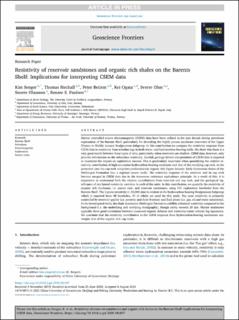| dc.contributor.author | Senger, Kim | |
| dc.contributor.author | Birchall, Thomas | |
| dc.contributor.author | Betlem, Peter | |
| dc.contributor.author | Ogata, Kei | |
| dc.contributor.author | Ohm, Sverre Ekrene | |
| dc.contributor.author | Olaussen, Snorre | |
| dc.contributor.author | Paulsen, Renate Strugstad | |
| dc.coverage.spatial | Barents sea | en_US |
| dc.date.accessioned | 2021-11-02T11:57:29Z | |
| dc.date.available | 2021-11-02T11:57:29Z | |
| dc.date.created | 2020-09-26T17:58:58Z | |
| dc.date.issued | 2021-11 | |
| dc.identifier.citation | Senger, K., Birchall, T., Betlem, P. et al. (2021) Resistivity of reservoir sandstones and organic rich shales on the Barents Shelf: Implications for interpreting CSEM data. Geoscience Frontiers, 12(6), 1-17. | en_US |
| dc.identifier.issn | 1674-9871 | |
| dc.identifier.uri | https://hdl.handle.net/11250/2827271 | |
| dc.description.abstract | Marine controlled source electromagnetic (CSEM) data have been utilized in the past decade during petroleum exploration of the Barents Shelf, particularly for de-risking the highly porous sandstone reservoirs of the Upper Triassic to Middle Jurassic Realgrunnen Subgroup. In this contribution we compare the resistivity response from CSEM data to resistivity from wireline logs in both water- and hydrocarbon-bearing wells. We show that there is a very good match between these types of data, particularly when reservoirs are shallow. CSEM data, however, only provide information on the subsurface resistivity. Careful, geology-driven interpretation of CSEM data is required to maximize the impact on exploration success. This is particularly important when quantifying the relative resistivity contribution of high-saturation hydrocarbon-bearing sandstone and that of the overlying cap rock. In the presented case the cap rock comprises predominantly organic rich Upper Jurassic–Early Cretaceous shales of the Hekkingen Formation (i.e. a regional source rock). The resistivity response of the reservoir and its cap rock become merged in CSEM data due to the transverse resistance equivalence principle. As a result of this, it is imperative to understand both the relative contributions from reservoir and cap rock, and the geological significance of any lateral resistivity variation in each of the units. In this contribution, we quantify the resistivity of organic rich mudstone, i.e. source rock, and reservoir sandstones, using 131 exploration boreholes from the Barents Shelf. The highest resistivity (>10,000 Ωm) is evident in the hydrocarbon-bearing Realgrunnen Subgroup which is reported from 48 boreholes, 43 of which are used for this study. Pay zone resistivity is primarily controlled by reservoir quality (i.e. porosity and shale fraction) and fluid phase (i.e. gas, oil and water saturation). In the investigated wells, the shale dominated Hekkingen Formation exhibits enhanced resistivity compared to the background (i.e. the underlying and overlying stratigraphy), though rarely exceeds 20 Ωm. Marine mudstones typically show good correlation between measured organic richness and resistivity/sonic velocity log signatures. We conclude that the resistivity contribution to the CSEM response from hydrocarbon-bearing sandstones outweighs that of the organic rich cap rocks | en_US |
| dc.language.iso | eng | en_US |
| dc.publisher | Elsevier Ltd. | en_US |
| dc.rights | Attribution-NonCommercial-NoDerivatives 4.0 Internasjonal | * |
| dc.rights.uri | http://creativecommons.org/licenses/by-nc-nd/4.0/deed.no | * |
| dc.subject | petroleumsgeologi | en_US |
| dc.subject | Barentshylla | en_US |
| dc.title | Resistivity of reservoir sandstones and organic rich shales on the Barents Shelf: Implications for interpreting CSEM data | en_US |
| dc.type | Peer reviewed | en_US |
| dc.type | Journal article | en_US |
| dc.description.version | publishedVersion | en_US |
| dc.rights.holder | © 2020 ChinaUniversity of Geosciences (Beijing) and Peking University. Production and hosting by Elsevier B.V. | en_US |
| dc.subject.nsi | VDP::Matematikk og Naturvitenskap: 400::Geofag: 450::Mineralogi, petrologi, geokjemi: 462 | en_US |
| dc.subject.nsi | VDP::Teknologi: 500::Berg‑ og petroleumsfag: 510::Geoteknikk: 513 | en_US |
| dc.source.pagenumber | 1-17 | en_US |
| dc.source.volume | 12 | en_US |
| dc.source.journal | Geoscience Frontiers | en_US |
| dc.source.issue | 6 | en_US |
| dc.identifier.doi | 10.1016/j.gsf.2020.08.007 | |
| dc.identifier.cristin | 1833784 | |
| dc.relation.project | Norges forskningsråd: 228107 | en_US |
| dc.relation.project | Norges forskningsråd: 257579 | en_US |
| cristin.ispublished | true | |
| cristin.fulltext | original | |
| cristin.fulltext | original | |
| cristin.qualitycode | 1 | |

